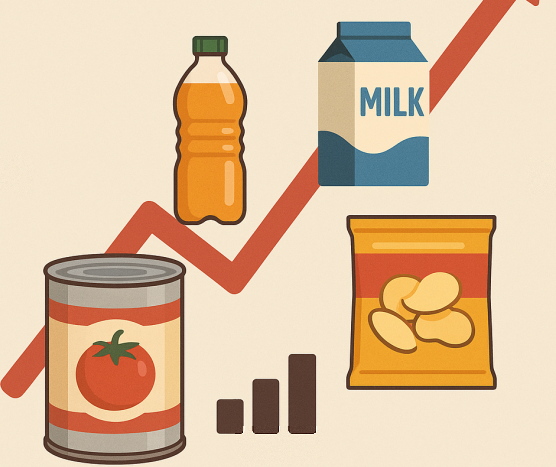The European exporting Firms in the Food sector
An analysis of the export propensity of major European exporting countries
Published by Silvia Brianese. .
Foreign markets Export Foreign market analysis From the analysis conducted in the article European exporting companies: a comparative analysis, it was highlighted how micro enterprises in the manufacturing sector suffer from their small size mainly in the initial phase of entering foreign markets, rather than in a more advanced stage of the internationalization process.
However, this difficulty can vary depending on the country considered and the different segments of the manufacturing sector. In this article, therefore, we analyze the export propensity of the main European exporting countries (Italy, Germany, Spain, and France) focusing on the food sector[1].
Export Propensity by Size Class
The first step in analyzing the degree of openness of an economy is to examine the share of exports in the turnover of companies active in the food sector.
Export Propensity of Active Companies, Food Sector, 2022
| Italy | Germany | Spain | France | |
| Total | 19.77% | 19.99% | 20.79% | 16.51% |
|---|---|---|---|---|
| From 0 to 9 persons employed | 4.83% | 6.49% | 6.15% | 1.66% |
| From 10 to 49 persons employed | 15.69% | 9.68% | 19.08% | 4.92% |
| From 50 to 249 persons employed | 26.59% | 19.67% | 20.49% | 18.22% |
| 250 persons employed or more | 20.25% | 21.55% | 23.01% | 18.50% |
Source: StudiaBo elaborations on Eurostat data
From the table, it emerges that in the food sector, Spain shows the highest export propensity compared to other countries, followed closely by Germany and Italy. This represents a slightly different scenario compared to the entire manufacturing sector, where Germany was the leader in exports.
In general, however, it is noted that export propensity tends to increase with the size of the company. In the Italian context, however, two main "extreme" cases emerge: micro food enterprises (0-9 employees) have an export propensity below the average of all other exporters, while medium-sized food enterprises (50-249 employees) are the most export-oriented, dominating their European counterparts of the same size.
Number of Exporting Companies
Another aspect of interest concerns the share of exporting companies. The following table shows the percentage calculated on the total number of active companies for each analyzed cluster.
Share of Exporting Companies on Total Active Companies, Food Sector, 2022
| Italy | Germany | Spain | France | |
| From 0 to 9 persons employed | 7.53% | 7.87% | 10.07% | 1.70% |
|---|---|---|---|---|
| From 10 to 49 persons employed | 45.36% | 12.73% | 45.09% | 11.88% |
| From 50 to 249 persons employed | 87.93% | 43.92% | 61.98% | 62.70% |
| 250 perons employed or more | 82.19% | 68.69% | 86.61% | 82.33% |
Source: StudiaBo elaborations on Eurostat data
From the table, it immediately emerges that Italy stands out from the other countries for the high share of small and, especially, medium-sized exporting companies in the food sector. The success of Italian SMEs in foreign markets can be partly attributed to the strength of the "Made in Italy" brand, which gives food products a competitive advantage in the international market.
As for micro exporting enterprises, Spain holds the largest share, suggesting that, in the food sector, Spanish micro enterprises receive greater support in their expansion into foreign markets compared to the other countries considered.
Italian micro enterprises thus appear to face greater challenges in accessing foreign markets. At the same time, a strength of Italy is represented by its small and medium-sized enterprises, which stand out for their significant export activity, particularly supported by the strength of the "Made in Italy" brand. The brand for Italian excellence is indeed a fundamental element in supporting the competitiveness of Italian food products in international markets.
Share of Revenue Generated Abroad by Size Class
Analyzing the percentage of sales generated in foreign markets by exporting companies is useful for more accurately assessing the degree of openness of an economy. Since available statistics do not allow for a direct measurement of the share of foreign sales by exporting companies, simplifying assumptions have been introduced to estimate the revenue of exporting companies alone. In particular, assuming that the revenue level of a company depends only on its size and not on whether it is an exporter or not, it is possible to estimate the total revenue of exporting companies and use this estimate to determine their export propensity.
Share of Revenue Generated Abroad, Food Sector, 2022
| Italy | Germany | Spain | France | |
| From 0 to 9 persons employed | 64.06% | 82.48% | 61.14% | 97.93% |
|---|---|---|---|---|
| From 10 to 49 persons employed | 34.58% | 76.08% | 42.32% | 41.45% |
| From 50 to 249 persons employed | 30.23% | 44.80% | 33.07% | 29.05% |
| 250 persons employed or more | 24.63% | 31.38% | 26.57% | 22.48% |
Source: StudiaBo elaborations on Eurostat data
Although this data should be interpreted with caution, especially where the share of exporting companies out of the total active companies is very small, overall, for the food sector as well, the share of revenue generated abroad does not depend on the size of the company. This conclusion is consistent with what has already been observed for the entire manufacturing sector.
Conclusions
These considerations allow us to describe a general picture of the export propensity of various countries in the food sector. However, using an inferential approach, it is possible to delve deeper into the topic by analyzing the relationship between the share of exporting companies and business performance, measured through two variables: labor productivity (i.e., value added per employee) and gross operating surplus (evaluated as a measure of the company's operational profitability).
The following table therefore reports the values of the correlations between these variables, related to the food sector and calculated across all four countries and for the various size classes.
Correlation Matrix between the Share of Exporting Companies, Labor Productivity, and Gross Operating Surplus, Food Sector, 2022
| Share of Exporting Companies | Gross Operating Surplus | Labor Productivity | |
| Share of Exporting Companies | 1.00 | 0.61 | 0.53 |
|---|---|---|---|
| Gross Operating Surplus | 0.61 | 1.00 | 0.36 |
| Labor Productivity | 0.53 | 0.36 | 1.00 |
Source: StudiaBo elaborations on Eurostat data
After verifying that the correlation between labor productivity and gross operating surplus reflects what is expressed by economic theory (i.e., a positive and increasing relationship by size class), a positive correlation is observed between the share of exporting companies and labor productivity, and between the share of exporting companies and gross operating surplus. Therefore, the analysis of the correlation between these variables provides further information regarding the openness of an economy to foreign markets: the results, in fact, suggest[3] that exporting companies tend to have high performance and that greater access to international markets corresponds to greater business efficiency.
Unlike the other countries considered in the analysis, in Italy, micro enterprises face greater challenges in accessing foreign markets for the food sector. At the same time, a strength of Italy is represented by small and medium-sized enterprises, which stand out for their significant export activity, particularly supported by the strength of the "Made in Italy" brand. The brand for Italian excellence is indeed a fundamental element in supporting the competitiveness of Italian food products in international markets.
[1] The food sector (code C10 according to the Nace Rev.2 classification) refers only to food industries, excluding beverage production.
[2] Assocamerestero, "Observatory on the agri-food sector in Spain", January 31, 2024
[3] As is known, correlation does not imply causation between different variables, so the relationship suggested in the text is our interpretation.


